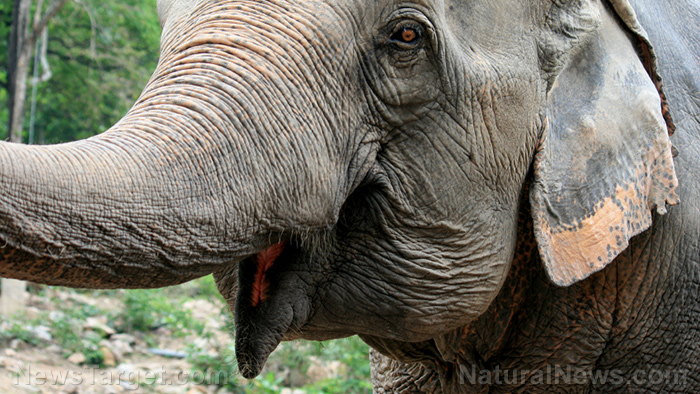Biologists film elephant smoking: One pachyderm in India seems to have developed a strange new habit
04/19/2018 / By Frances Bloomfield

Elephants aren’t known for eating burned wood then breathing out smoke. Yet that’s exactly what conservation scientists at India’s Nagarahole National Park came across while checking out hidden camera traps.
In the 57-second video, a female Asian elephant can be seen scooping up chunks of ashen wood with her trunk and stuffing them into her mouth. Every time she does so, the elephant exhales plumes of smoke. Interestingly, there were no signs of ashen wood being spat back out, indicating that the animal was swallowing them.
Vinay Kumar, assistant director of the Wildlife Conservation Society’s (WCS) India program, explained that he and his team came across the animal while inspecting cameras intended to capture footage of tigers and their prey. She was standing in a burnt patch in the forest, itself a result of forest fire control work.
“In India, the Forest Department burns fire lines to create fire breaks that can help control forest fires. And this effort leaves behind wood charcoal on the forest floor,” said Kumar.
As for what the elephant was doing with charcoal, elephant biologist Dr. Varun Goswami believes that the actions may be curative in nature. “I believe the elephant may have been trying to ingest wood charcoal,” he explained, then noted, “Charcoal has toxin-binding properties that may provide medicinal value.” (Related: Discover Four New Ways to Use Charcoal–And They Don’t Include Barbecuing.)
Animals utilizing charcoal to remedy their ills isn’t entirely new. In 1997, a team of researchers discovered that Zanzibar red colobus monkeys were wont to stuffing themselves with charcoal. Charcoal, which is mostly made up of carbon, offers little to no nutritional value. Instead, the monkeys were most likely consuming charcoal for its ability to bind with the toxic phenols found in the leaves of Indian almond and mango trees. Though charcoal absorbs phenols, it has no effect on the protein in the leaves.
Moreover, this isn’t the first instance of elephants using nature to their advantage. Ecologist Dr. Holly T. Dublin witnessed a heavily pregnant female elephant at Kenya’s Tsavo Park deviate from her daily feeding routine. The elephant walked for miles without stopping to eat until she found a small tree related to the borage plant. According to Dublin, the animal devoured the tree until it was little more than a stump. After four days, the elephant gave birth. Later investigations revealed that the leaves and bark of this tree are known for inducing uterine contractions. So much so that Kenyan women often drink a tea made from its leaves to either encourage labor or abortion.
How exactly the elephants in Nagarahole National Park and Tsavo Park came to possess such medicinal knowledge is a mystery. It might be instinct, or it might be knowledge passed down from one generation of elephants to the next. That’s how Namibian desert elephants are able to thrive in the harsh conditions of Africa’s Namib desert. Nothing in their DNA has pointed to them being genetically different from other elephants across the continent, meaning that their uncanny survival skills are the products of shared knowledge learning. Maybe that’s what prompted the “smoke-breathing” elephant to eat chunks of charcoal.
Visit Environ.news for more news stories about wildlife all over the world.
Sources include:
Tagged Under: animal behavior, animals, charred wood, eating charcoal, elephants, Nagarahole National Park, smoking, smoking elephant, unusual animal behavior, weird science, wildlife




















